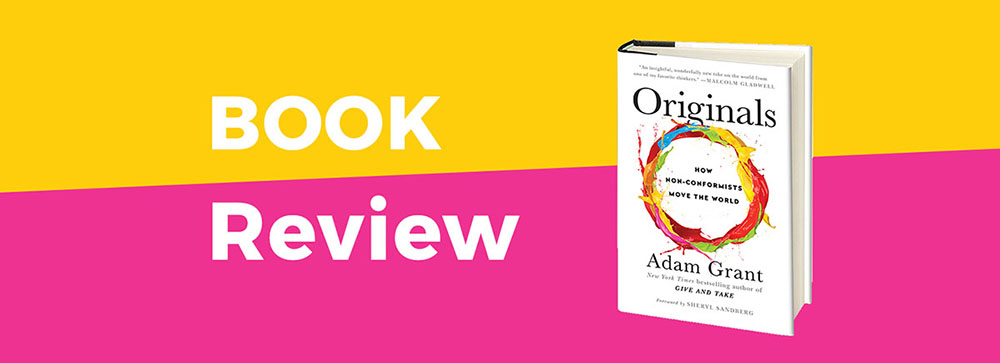The self-help market is saturated with the books that either mystify creativity as a halo over a few chosen ones or overly-simplify it as bullet points. Adam Grant’s ‘Originals: How Non-Conformists Move the World’ is a refreshingly nuanced effort in this genre. The book’s biggest achievement is demystifying originality. Originals, says Grant, are the ones who take the road less traveled, championing a set of novel ideas that go against the grain but ultimately make things better. Originals can be world-famous inventors, entrepreneurs, authors and activists. Originals can also be lesser-known employees or anonymous individuals who champion original ideas. The only thing they have in common? They made the choice to be original.
Adam Grant has compiled numerous studies and supplemented them with his own research to create this guide for those who want to be originals. Here are some answers and other gems from the book that stayed with me after the first reading:
What is being original? Is there absolute originality? What is the difference between originality and creativity?
‘There are two routes to achievement: conformity and originality. Conformity means following the crowd down conventional paths and maintaining the status quo. Originality is taking the road less traveled.’
‘Nothing is completely original. We are constantly borrowing thoughts, whether intentionally or inadvertently. We’re all vulnerable to ‘kleptomnesia’- accidentally remembering the ideas of others as our own. Originality involves introducing and advancing an idea that’s relatively unusual within a particular domain, and that has the potential to improve it.’
‘Originality itself starts with creativity: generating a concept that is both novel and useful. But it does not stop there. Originals are people who take the initiative to make their visions a reality.’
How can we be originals?
‘The starting point is curiosity: pondering why the default exists in the first place. When we become curious about the dissatisfying defaults in our world, we begin to recognize that most of them have social origins: rules and systems were created by people. And that awareness gives us the courage to contemplate how we can change them.’
Debunking myths on originality
The best part of the book is Grant’s thorough debunking of myths on originality. These are some of the myths that he successfully debunks:
- Child prodigies become originals: ‘Only a fraction of gifted children eventually become revolutionary adult creators. Child prodigies are hindered by achievement motivation. The more you value achievement, the more you come to dread failure. Instead of aiming for unique accomplishments, the intense desire to succeed leads us to strive for guaranteed success.’
- Originals are immune to risks: ‘ We believe that great creators are impervious to fear, rejection and ridicule. But originals are actually far more ordinary than we realize. As they question traditions and challenge the status quo, they may appear bold and self-assured on the surface. But when you peel back the layers, the truth is that they, too, grapple with fear, ambivalence and self-doubt. ‘
- Procrastination kills originality: ‘Procrastination seems to be a common habit of creative thinkers and great problem solvers. They used procrastination as a form of incubation to stave off a premature choice. It also keeps us open to improvisation.’
- Originality is born of deep experience or uncommon intuition: Grant thinks that experience and intuition do not have straight-forward relation with originality. ‘Unique combination of broad and deep experience is critical for creativity.‘
- Originals show themselves young: Grant thinks that there is no single age that has monopoly on originality. The time at which we reach our heights of originality, and how long they last, depends on our styles of thinking.
After reading Grant, it feels that being original is not as inaccessible as it looked before. But originality is not just coming up with original ideas but also turning creative visions into reality.
Championing novel and creative ideas might run against a lot of resistance. Grant talks about strategies and practical tips to change the status quo:
- ‘There are four different options of handling a dissatisfying situation: exit, voice, persistence and neglect. In the quest for originality, neglect isn’t an option. Persistence maintains the status quo. The best we can do is voice our opinions and secure our risk portfolios, preparing for exit if necessary. ‘
- ‘Even having a single ally is enough to dramatically increase your will to act. Find one person who believes in your vision and begin tackling the problem together.’
- ‘Repeat yourself- it makes people more comfortable with an unconventional idea. Reactions typically become more positive after ten to twenty exposures to an idea, particularly if they’re short, spaced apart by a few days, and mixed in with other ideas.’
He also has tips for leaders and parents for creating a culture that nurtures creativity. For organizations, he suggests they be wary of groupthink, welcome criticism and encourage diversity. For our children to grow up as originals, we should emphasize value over rules, ask them to consider a different frame of reference and create novel niches for them to pursue.
In conclusion:
In his book ‘Originals’, Adam Grant has debunked the myth that the originals are the extraordinary chosen ones and the crazy risk-takers. Nonconformists are more ordinary than we think. Originals are ordinary people who make extraordinary choices. It is about the cultivating the right mind-set, character, and culture. Originality is about rejecting the default, imagining alternatives and being strategic about turning the visions into reality. To be an original, we can start by being aware and curious.
Author: Dovan Rai
Dovan is passionate about education technology and worked at OLE Nepal, where she designed educational software for public schools in Nepal. She has a PhD in Computer Science from Worcester Polytechnic Institute, USA

Leave a Reply